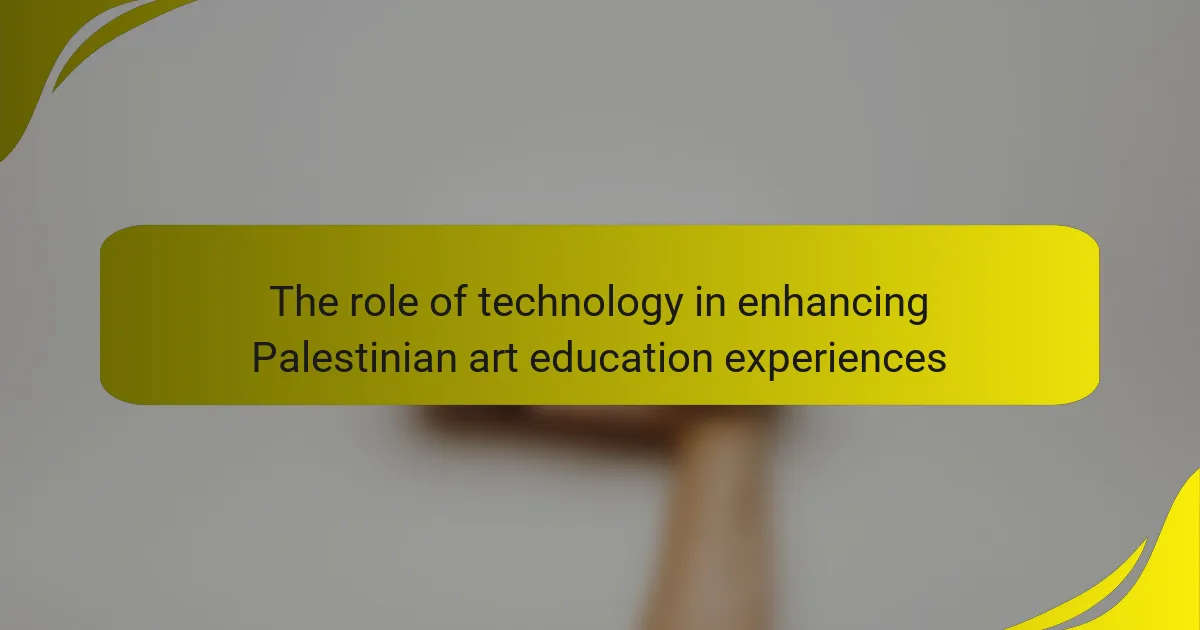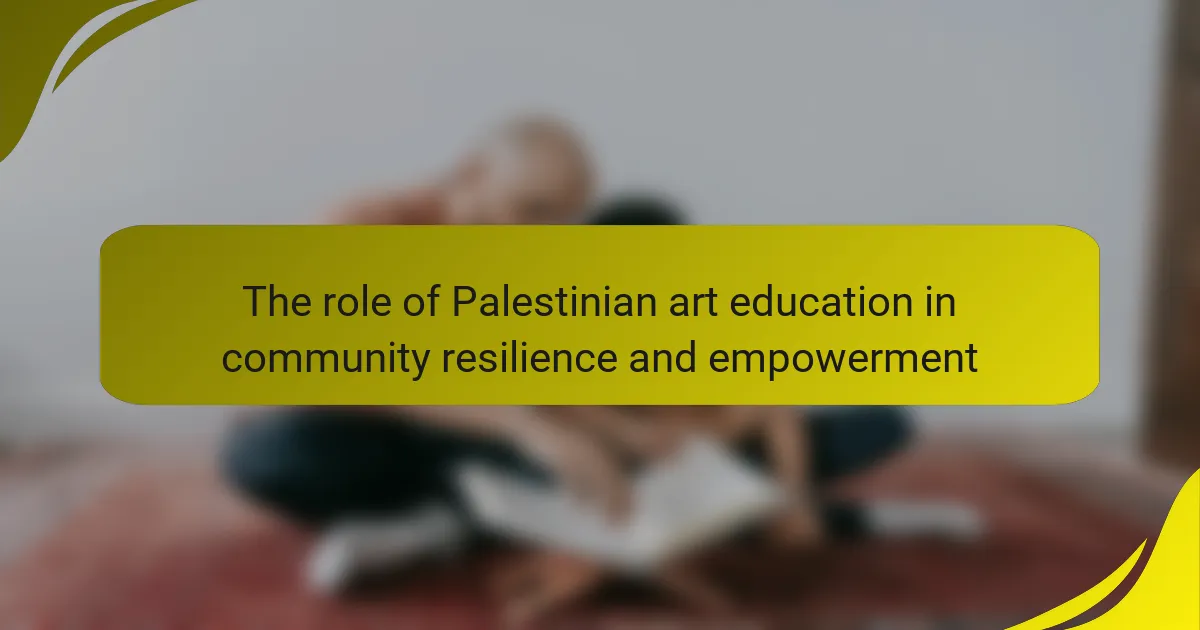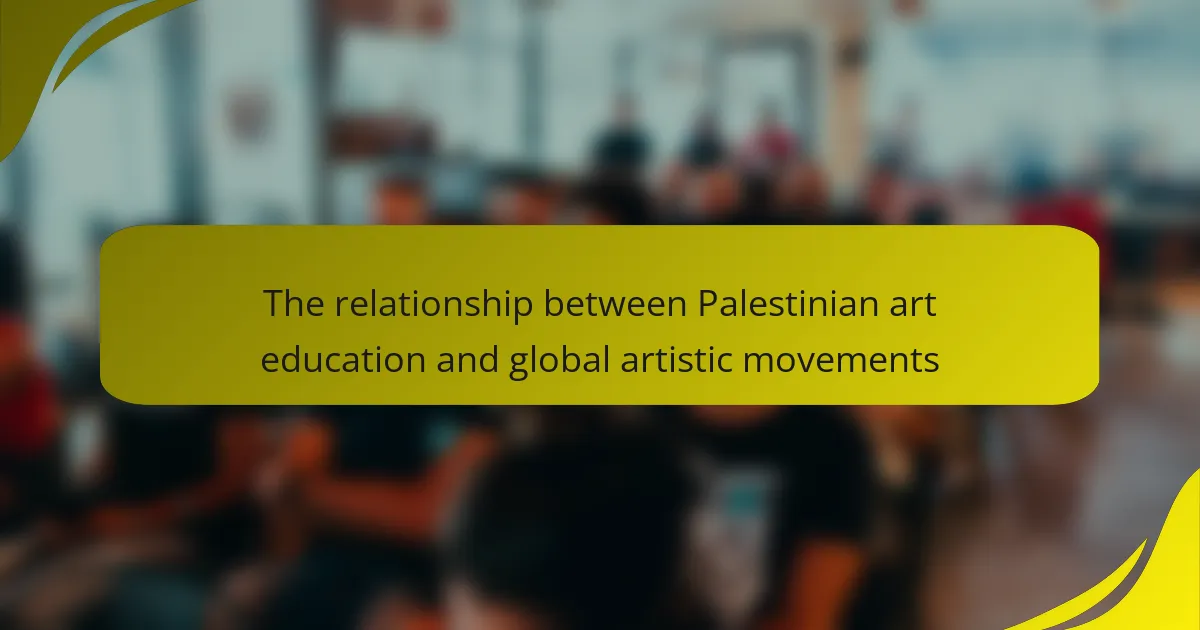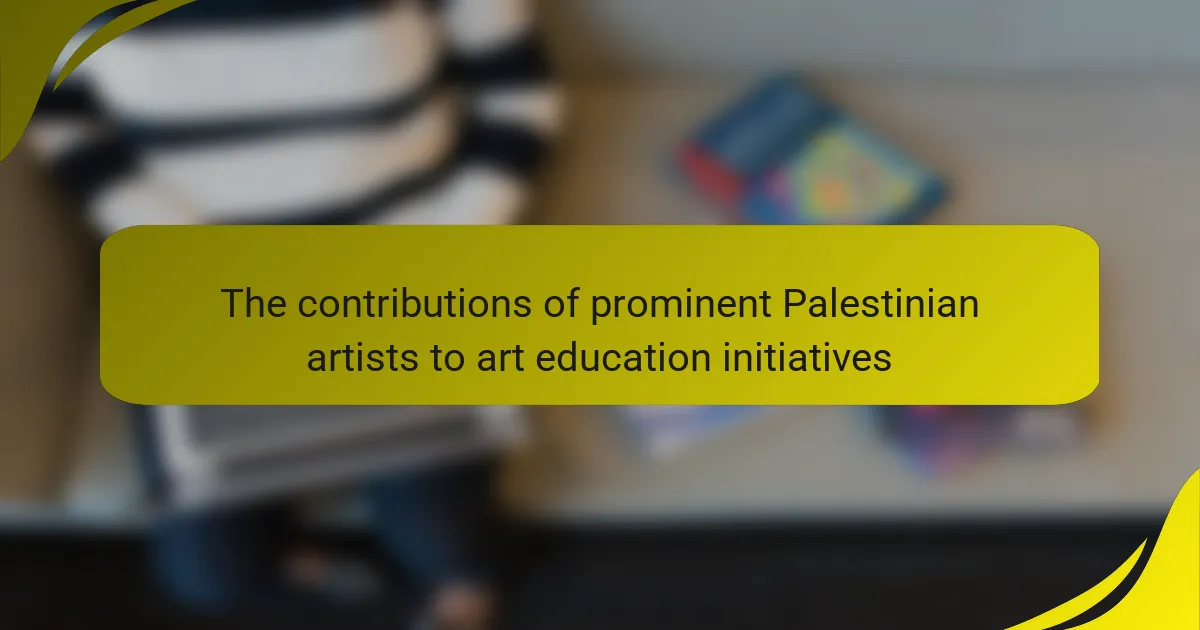The article examines the accessibility of art education in Palestinian communities, particularly those that are marginalized and under-resourced. It highlights the socio-political and economic barriers that hinder access to art programs, including financial constraints, limited resources, and cultural biases. Additionally, the article discusses various initiatives aimed at improving access to art education, such as community art centers, non-profit funding, and online platforms offering virtual classes. These efforts are designed to empower youth and enhance creativity, despite the challenges faced by these communities. The overall focus is on the disparities in art education opportunities and the impact of these initiatives on marginalized youth.
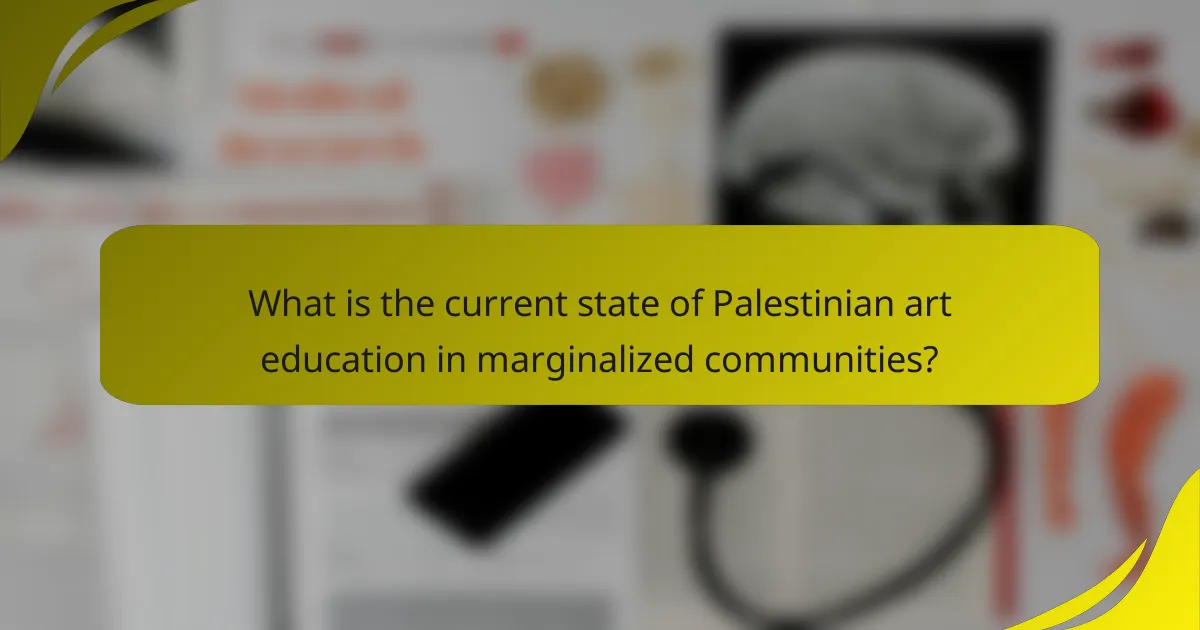
What is the current state of Palestinian art education in marginalized communities?
The current state of Palestinian art education in marginalized communities is limited and under-resourced. Access to art education is often hindered by socio-political factors. Many marginalized communities face economic challenges that restrict funding for art programs. Additionally, there is a lack of trained art educators in these areas. Cultural barriers also affect participation in art education. Some initiatives exist, but they struggle to reach wider audiences. Non-governmental organizations are working to improve access to art education. Their efforts aim to empower youth and foster creativity despite the challenges.
How accessible is art education for marginalized groups in Palestine?
Art education is limited for marginalized groups in Palestine. Access is hindered by socio-economic barriers, political instability, and lack of resources. Many communities lack formal art programs and trained instructors. Cultural restrictions further complicate participation in art education. Organizations like the Al-Quds University have made efforts to promote art education. However, these initiatives often face funding challenges. The ongoing conflict also disrupts educational opportunities. Consequently, marginalized groups struggle to access quality art education in Palestine.
What factors contribute to the accessibility of art education?
Factors that contribute to the accessibility of art education include socioeconomic status, availability of resources, and institutional support. Socioeconomic status affects individuals’ ability to afford art supplies and classes. Availability of resources includes access to community centers and schools offering art programs. Institutional support refers to funding and policies that promote art education in underserved areas. Research shows that marginalized communities often lack these resources, leading to reduced access. Programs designed to address these gaps can improve accessibility significantly.
How do socio-economic conditions affect access to art education?
Socio-economic conditions significantly affect access to art education. Individuals from lower socio-economic backgrounds often face barriers such as limited financial resources. These barriers can restrict access to art supplies, classes, and extracurricular activities. Additionally, schools in underprivileged areas may lack funding for comprehensive art programs. Research indicates that students in wealthier districts have more opportunities for diverse art education. For instance, a study by the National Endowment for the Arts found that students in affluent communities participate in arts education at higher rates than those in low-income areas. This disparity highlights how socio-economic factors create unequal access to art education.
What role does cultural context play in art education accessibility?
Cultural context significantly influences art education accessibility. It shapes the relevance of art curricula to students’ lives. In marginalized communities, cultural background affects engagement with art forms. For instance, local traditions may be undervalued in standardized programs. This can lead to disinterest among students. Moreover, cultural context dictates resource availability for art education. Communities with rich artistic heritage may have more local support. Conversely, those lacking recognition may struggle to access materials and mentorship. Research shows that culturally responsive pedagogy enhances student participation. Programs tailored to specific cultural contexts improve educational outcomes.
How do cultural perceptions influence participation in art education?
Cultural perceptions significantly influence participation in art education. These perceptions shape attitudes toward the value of art and creativity. In marginalized communities, cultural beliefs may prioritize practical skills over artistic expression. This can lead to lower enrollment in art programs. Additionally, cultural stigmas surrounding certain art forms may discourage participation. For example, traditional views may limit acceptance of contemporary art practices. Research indicates that communities with strong cultural appreciation for art see higher participation rates. According to a study by the Arts Council of England, increased community engagement in the arts correlates with positive cultural perceptions. Thus, cultural context directly impacts access and involvement in art education.
What are the historical influences on Palestinian art education in these communities?
Palestinian art education has been historically influenced by various socio-political and cultural factors. The Ottoman Empire’s rule established early educational frameworks that included art. After the fall of the Ottoman Empire, British colonial rule introduced Western educational models, impacting art curricula. The 1948 Nakba led to displacement, affecting access to art education in refugee communities. The Israeli occupation further restricted resources and opportunities for artistic expression. Additionally, local cultural heritage and traditions have shaped the content and methods of art education. Organizations like the Palestinian Ministry of Culture and various NGOs have worked to promote art education despite these challenges.
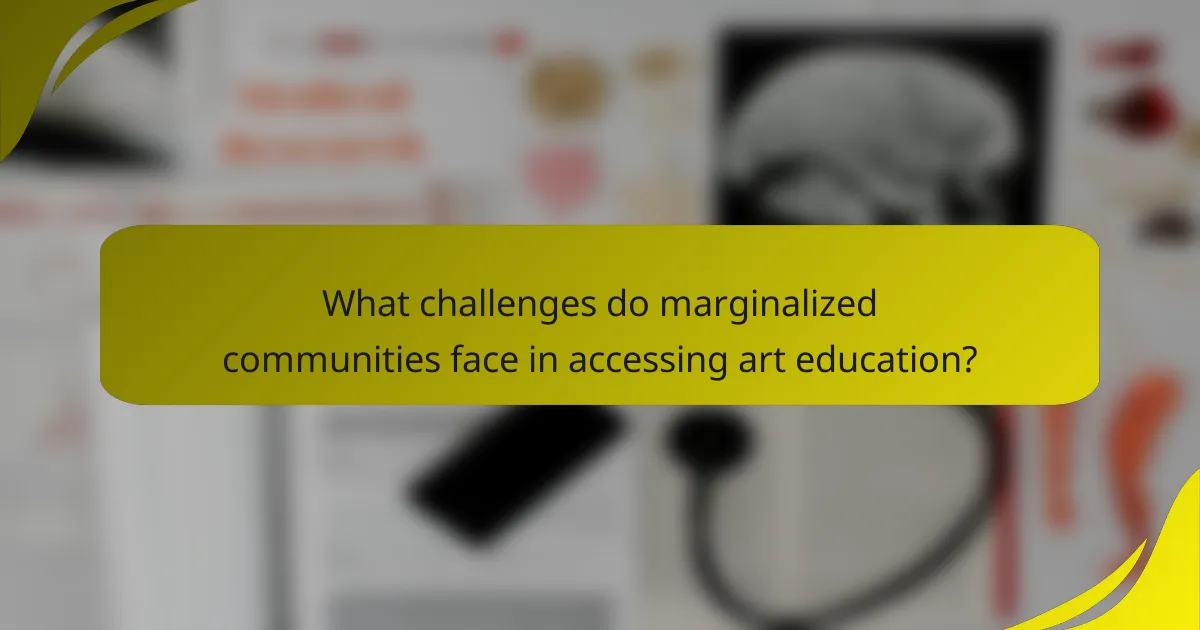
What challenges do marginalized communities face in accessing art education?
Marginalized communities face significant challenges in accessing art education. These challenges include financial barriers, limited resources, and institutional discrimination. Many individuals in these communities cannot afford art supplies or classes. Schools in marginalized areas often lack funding for arts programs. Additionally, cultural biases may lead to a lack of representation in art curricula. Transportation issues can further hinder access to art education facilities. According to a 2021 report by the National Endowment for the Arts, low-income areas have fewer art education opportunities. This disparity affects the ability of marginalized youth to engage in artistic expression and development.
What are the primary barriers to art education in Palestine?
The primary barriers to art education in Palestine include political conflict, economic instability, and limited resources. Political conflict restricts access to educational institutions and disrupts curricula. Economic instability limits funding for art programs and materials. Limited resources include a shortage of trained art educators and inadequate facilities. These barriers significantly hinder the development of comprehensive art education. According to a report by the United Nations Educational, Scientific and Cultural Organization (UNESCO), these factors contribute to a lack of opportunities for artistic expression among Palestinian youth.
How does lack of funding impact art education programs?
Lack of funding severely impacts art education programs. It leads to reduced resources for materials and supplies. Programs may face cuts in class offerings and teacher positions. This results in fewer opportunities for students to engage with art. Limited funding also restricts access to field trips and guest artists. Consequently, students miss out on diverse artistic experiences. Research shows that schools with adequate funding see higher student engagement and success in the arts. Without financial support, art education programs struggle to thrive and meet community needs.
What logistical challenges do students encounter in accessing art education?
Students encounter several logistical challenges in accessing art education. Limited transportation options hinder students from reaching art institutions. Geographic isolation in marginalized communities exacerbates this issue. Additionally, inadequate funding for art programs restricts resources and opportunities. Scheduling conflicts with other educational commitments further complicate access. Students often lack access to necessary materials and supplies for art projects. Furthermore, limited availability of qualified art educators affects the quality of instruction. These challenges collectively impact the overall accessibility of art education for students in marginalized communities.
How do political factors influence art education accessibility?
Political factors significantly influence art education accessibility in marginalized communities. Government policies dictate funding levels for educational programs. In Palestine, political instability often leads to reduced resources for art education. Restrictions on movement can hinder access to schools and art institutions. Additionally, political ideologies may shape the curriculum, limiting artistic expression. In 2018, a report by the Palestinian Ministry of Education indicated a 30% decrease in arts funding due to political constraints. This directly impacts the availability of art supplies and trained educators. Furthermore, societal attitudes influenced by politics can discourage participation in art programs. Overall, political factors create barriers that limit access to quality art education in these communities.
What role do governmental policies play in shaping art education?
Governmental policies significantly influence the structure and availability of art education. These policies determine funding levels for arts programs in schools. They also establish curriculum standards that include or exclude art subjects. Furthermore, policies can promote access to art education in marginalized communities. For instance, initiatives may target underfunded schools to enhance art resources. Historical data shows that regions with supportive arts policies report higher student engagement in creative subjects. Additionally, government grants can provide essential materials and training for art educators. Overall, the role of governmental policies is crucial in shaping equitable access to art education.
How do conflicts affect the availability of art education resources?
Conflicts significantly reduce the availability of art education resources. In conflict zones, funding for educational programs often diminishes. Schools may close or repurpose facilities for emergency needs. This limits access to art supplies and qualified instructors. Additionally, instability disrupts community engagement in arts initiatives. Reports indicate that regions experiencing prolonged conflict see a decline in cultural activities. For instance, UNESCO has documented significant losses in educational resources in war-affected areas. Therefore, the impact of conflict directly correlates with diminished art education opportunities.
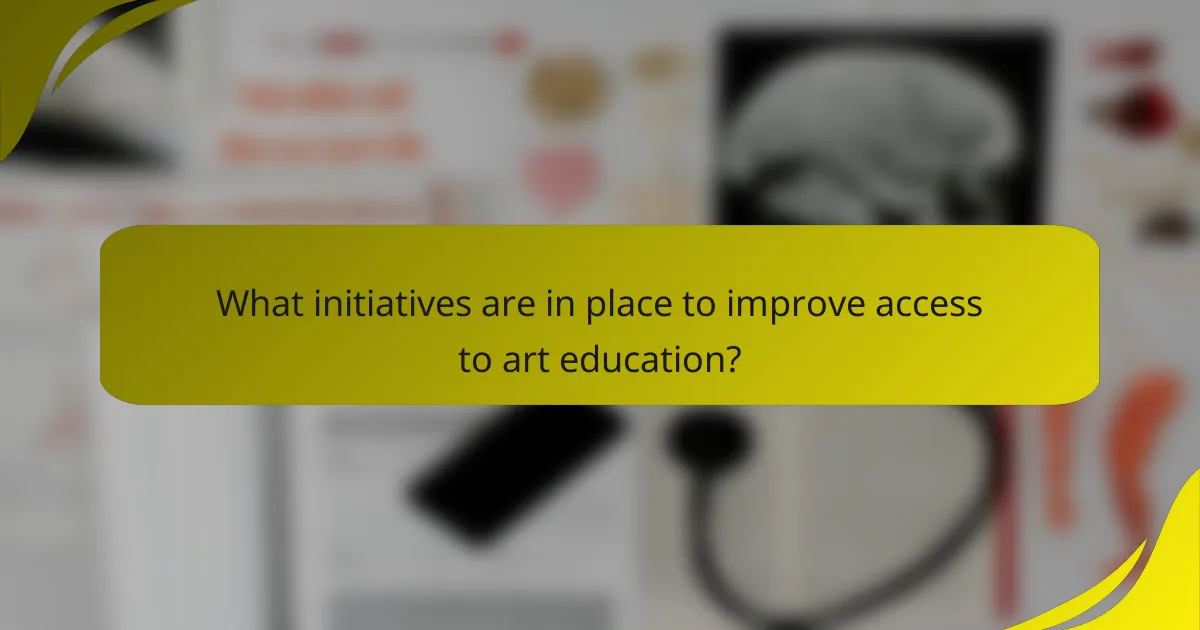
What initiatives are in place to improve access to art education?
Various initiatives aim to improve access to art education in marginalized communities. One initiative is the establishment of community art centers that offer free or low-cost art classes. These centers often collaborate with local artists to provide workshops and mentorship.
Additionally, non-profit organizations frequently fund art programs in schools that lack resources. These programs are designed to enhance creativity and self-expression among students.
Government grants also support art education initiatives, ensuring funding for projects in underserved areas. Research shows that access to art education can significantly boost academic performance and emotional well-being.
Furthermore, online platforms are emerging, offering virtual art classes that reach a broader audience. This approach breaks geographical barriers and provides flexibility for learners.
Collectively, these initiatives contribute to a more inclusive environment for art education, particularly in Palestinian communities facing challenges.
What programs exist to support art education in marginalized communities?
Programs that support art education in marginalized communities include Art for Change, The DreamYard Project, and The Art of Education University. Art for Change focuses on empowering youth through creative expression in underprivileged areas. The DreamYard Project provides arts education to students in the Bronx, fostering creativity and critical thinking. The Art of Education University offers resources and professional development for art educators, emphasizing inclusivity. These programs aim to bridge the gap in access to quality art education for marginalized groups. Research shows that art education can enhance academic performance and social skills in disadvantaged youth.
How effective are community-based art education initiatives?
Community-based art education initiatives are highly effective in fostering creativity and community engagement. They provide accessible platforms for marginalized groups to express themselves. These initiatives often lead to improved social cohesion and individual empowerment. Research indicates that participants experience increased self-esteem and enhanced social skills. A study by the National Endowment for the Arts found that community art programs significantly improve participants’ quality of life. Additionally, these initiatives can contribute to cultural preservation and identity reinforcement. Evidence shows that art education can bridge gaps in access to traditional educational resources. Overall, community-based art education initiatives play a crucial role in enriching lives and communities.
What partnerships have been formed to enhance art education access?
Partnerships have been formed between local NGOs, educational institutions, and international organizations to enhance art education access. These collaborations aim to provide resources, training, and opportunities for marginalized communities. For instance, the partnership between the Palestinian Art Academy and the United Nations Relief and Works Agency focuses on integrating art into the curriculum for refugee schools. Additionally, alliances with local community centers facilitate workshops and art programs for youth. These initiatives have increased participation and exposure to artistic practices. Evidence shows that such partnerships have improved access to art education significantly in underserved areas.
What best practices can be implemented to improve accessibility?
Implementing best practices to improve accessibility includes several key strategies. First, providing alternative formats for educational materials enhances access for all learners. This can include audio, large print, and Braille versions. Second, using assistive technologies can support individuals with disabilities. Tools like screen readers and speech recognition software are effective. Third, ensuring physical spaces are wheelchair accessible is crucial. This includes ramps, elevators, and accessible restrooms. Fourth, training educators on inclusive teaching methods fosters a supportive learning environment. Research shows that inclusive practices lead to better educational outcomes. Lastly, engaging with the community to understand specific needs ensures relevant accessibility measures are taken. These practices create a more inclusive art education experience for marginalized communities.
How can local organizations better support art education initiatives?
Local organizations can better support art education initiatives by providing funding and resources. Financial support can help schools purchase art supplies and materials. Additionally, organizations can offer scholarships for art programs. Collaborating with local artists can enhance curriculum quality. Workshops led by professionals can inspire students and teachers alike. Establishing community art events can showcase student work and promote engagement. Research shows that increased funding correlates with improved educational outcomes in the arts. For example, a study by the Arts Education Partnership found that schools with dedicated funding for arts education see higher student participation and achievement.
What innovative approaches are being used to overcome barriers in art education?
Innovative approaches to overcome barriers in art education include community-based programs and digital platforms. Community-based programs engage local artists to teach and mentor students. These programs often cater to marginalized groups, enhancing accessibility. Digital platforms provide online resources and virtual workshops. They allow students to access art education regardless of location. Collaborations with NGOs also support funding for art initiatives. These initiatives promote inclusivity and diversity in art education. Research indicates that such approaches significantly improve engagement and learning outcomes in underserved communities.
What practical steps can individuals take to support Palestinian art education?
Individuals can support Palestinian art education by donating to organizations that focus on art programs in Palestinian communities. These donations can provide essential resources such as art supplies and training. Volunteering time to teach art or mentor young artists is another effective method. Individuals can also promote Palestinian art through social media and local events. This raises awareness and appreciation for the culture. Attending exhibitions featuring Palestinian artists helps to provide them with visibility. Purchasing artwork directly from Palestinian artists supports their livelihoods and promotes their work. Lastly, advocating for policies that support educational initiatives in Palestine can lead to systemic change.
The main entity of this article is Palestinian art education, specifically its accessibility in marginalized communities. The article examines the current state of art education in Palestine, highlighting the socio-economic, political, and cultural barriers that hinder access. It discusses the impact of limited resources, lack of trained educators, and institutional discrimination on marginalized groups. Additionally, it explores existing initiatives and partnerships aimed at improving access to art education, as well as best practices that can enhance inclusivity. Overall, the article provides a comprehensive analysis of the challenges and opportunities within Palestinian art education.
